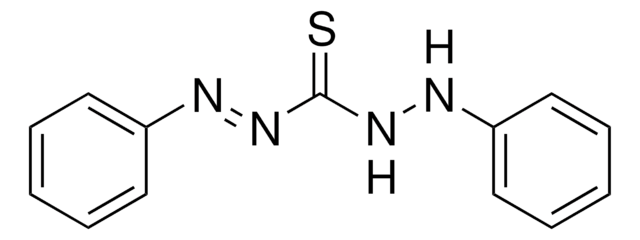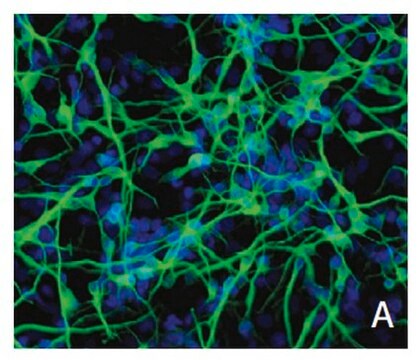SCR047
Pancreatic Cell DTZ Detection Assay
The Pancreatic Cell DTZ Detection Assay provides researcher a simple & quick method to identify insulin-producing beta cells from a mixed cell culture preparation or from pancreatic tissues.
Autenticatiper visualizzare i prezzi riservati alla tua organizzazione & contrattuali
About This Item
Codice UNSPSC:
12352207
eCl@ss:
32161000
Prodotti consigliati
Livello qualitativo
Reattività contro le specie (prevista in base all’omologia)
mammals
Produttore/marchio commerciale
Chemicon®
Millipore
tecniche
cell culture | stem cell: suitable
input
sample type pancreatic stem cell(s)
Metodo di rivelazione
colorimetric
Condizioni di spedizione
dry ice
Descrizione generale
The Pancreatic Cell DTZ Detection Assay provides researcher a simple and quick method to identify insulin-producing beta cells from a mixed cell culture preparation or from pancreatic tissues The kit contains pre-mixed Dithizone Stain, Rinsing Solution and filters for fast preparation and optimized results. Millipore′s Pancreatic Cell DTZ Detection Asssay (SCR047) takes advantage of the high zinc content of pancreatic beta cells and the known action of dithizone, a zinc-chelating agent, to provide a quick and simple enzymatic reaction that allows researcher to reliably identify insulin-producing beta cells from a mixed cell culture preparation or from pancreatic tissues. Along with selectively staining live pancreatic beta-islet cells crimson red, the enzymatic reaction has the advantage of being completely reversible. Kit components include staining and rinse solutions along with filters required for the live staining reactions. Sufficient reagents are supplied to provide for 10 enzymatic reactions at 10 mL volume.
The islets of Langerhans are groups of specialized cells that are dispersed throughout the pancreas. They produce a number of hormones including glucagon, insulin, Pancreatic polypeptide and somatostatin. Insulin is the most critical of these, as it helps regulate glucose metabolism. Insulin is synthesized from a precursor molecule, proinsulin, in the beta cells of the islets of Langerhans. The conversion of proinsulin into the active hormone, insulin, is accomplished by proteolytic enzymes known as prohormone convertases (PC1 and PC2) as well as the exoprotease carboxypeptidase E. These proteolytic enzymes remove the center portion of the molecule, or C-peptide, and the remaining peptide chains (A and B) are cross-linked by disulfide bonds. The crosslinked peptides are the insulin monomer. As the concentration of the protein increases, the monomers assemble into dimers and in the presence of zinc, into hexameric crystals characterized by two Zn2+ atoms per hexameric unit. It is this 2-Zn insulin hexamer that represents the active conformation of the secreted hormone. Given its prominent role in the synthesis, storage and secretion of insulin, it is not surprising that zinc is highly expressed in pancreatic beta cells.
Applicazioni
Research Category
Stem Cell Research
Stem Cell Research
The Pancreatic Cell DTZ Detection Assay provides researcher a simple & quick method to identify insulin-producing beta cells from a mixed cell culture preparation or from pancreatic tissues.
Componenti
1 mL of 100X DTZ Stain Solution (Part No: 2006182)
2 - 150 mL of 1X DTZ Rinse Solution (Part No: 2006183)
10 Millex GP 0.22 uM filters (Part No: SLGPR33RB)
12 Plastic Syringes, 20 mL w/ Luer slip (Part No: XX1102012)
2 - 150 mL of 1X DTZ Rinse Solution (Part No: 2006183)
10 Millex GP 0.22 uM filters (Part No: SLGPR33RB)
12 Plastic Syringes, 20 mL w/ Luer slip (Part No: XX1102012)
Stoccaggio e stabilità
Store DTZ Stain at -20C. Store all other reagents at room temperature.
Note legali
CHEMICON is a registered trademark of Merck KGaA, Darmstadt, Germany
Esclusione di responsabilità
Unless otherwise stated in our catalog or other company documentation accompanying the product(s), our products are intended for research use only and are not to be used for any other purpose, which includes but is not limited to, unauthorized commercial uses, in vitro diagnostic uses, ex vivo or in vivo therapeutic uses or any type of consumption or application to humans or animals.
Codice della classe di stoccaggio
10 - Combustible liquids
Classe di pericolosità dell'acqua (WGK)
WGK 2
Certificati d'analisi (COA)
Cerca il Certificati d'analisi (COA) digitando il numero di lotto/batch corrispondente. I numeri di lotto o di batch sono stampati sull'etichetta dei prodotti dopo la parola ‘Lotto’ o ‘Batch’.
Possiedi già questo prodotto?
I documenti relativi ai prodotti acquistati recentemente sono disponibili nell’Archivio dei documenti.
Il team dei nostri ricercatori vanta grande esperienza in tutte le aree della ricerca quali Life Science, scienza dei materiali, sintesi chimica, cromatografia, discipline analitiche, ecc..
Contatta l'Assistenza Tecnica.






